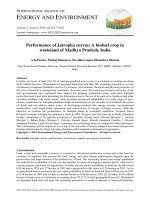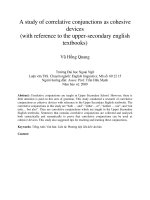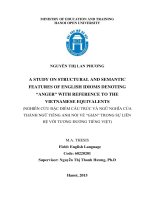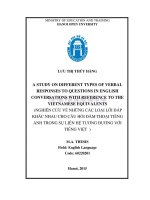Development of eggplant diseases with reference to meteorological parameter in kymore zone of Madhya Pradesh, India
Bạn đang xem bản rút gọn của tài liệu. Xem và tải ngay bản đầy đủ của tài liệu tại đây (298.79 KB, 8 trang )
Int.J.Curr.Microbiol.App.Sci (2018) 7(8): 3811-3818
International Journal of Current Microbiology and Applied Sciences
ISSN: 2319-7706 Volume 7 Number 08 (2018)
Journal homepage:
Original Research Article
/>
Development of Eggplant Diseases with Reference to Meteorological
Parameter in Kymore Zone of Madhya Pradesh, India
Krishan Kant Dhakad*, M.S. Bhale and S.N. Singh
Department of Plant Pathology, JNKVV Jabalpur-482004, Madhya Pradesh, India
*Corresponding author
ABSTRACT
Keywords
Eggplant diseases,
Disease
distribution,
Disease
development
Article Info
Accepted:
20 July 2018
Available Online:
10 August 2018
Eggplant (Solanum melongena L.) is an important Solanaceous crop widely grown in
different parts of the country. Incidence of Phomopsis fruit rot was observed at 39 th
standard week (October 2016) till 3rd standard week (January 2017) and incidence ranged
from 2.0-22.0%. Almost 10 time increase in fruit rot was recorded within 30 days during
October 2016 when the average temperature 23.65ºC with 55.5% relative humidity having
9.3 sunshine hours. The incidence ranged from 4.0-13.0% during 56th standard week
(maximum temperature 30.7ºC and minimum 13.6ºC with relative humidity (morning 82%
and evening 92%) provided the congenial condition and incidence up to 13.0% was
recorded. Bacterial wilt was not recorded at early stage however, the plant were infected
during pre-fruiting incidence of bacterial wilt which ranged from 4.0-13.0% under natural
field condition. The leaf spot (Cercospora melongenae) increased up to five times (3.015.0%) from 43rd-46th week when the average temperature was 18.2ºC with morning
humidity 88%. and remained constant till 49th week. Pin prick method was better and
typical symptoms on eggplant fruits were developed within 3-6 days in Pusa Round and 69 days in Pusa Purple long inoculated by Phomopsis vexans. In case of test virulence of
Cercospora melongenae it took 4-6 days of development and 7-8 days in pusa round and
Pusa Purple Long, respectively
Introduction
Brinjal or eggplant (Solanum melongena L.) is
an important Solanaceous crop of sub tropics
and tropics. The bringal, eggplant or
Aubergine (French name) has originated in
Indian sub-continent and China (Thompson
and Kelly, 1957). India is considered to be the
Centre of Origin of cultivated eggplant, from
where it spread to the other parts of the world
(Choudhury and Malda, 1968). Eggplant
contains 92.7 g moisture, 1.4 g of proteins and
4.0 g of carbohydrates, 0.3 g minerals, 124
I.U. vitamins and 12.0 mg vitamin C per 100 g
of edible portion (Kalra et al., 1988). It is low
in calories and fat, contain mostly water, little
protein, fibre and carbohydrate, water soluble
sugars, and vitamins (Bajaj et al., 1979).
Unripe fruits are used primarily as vegetable
throughout the country. It is also used as raw
material in pickle making (Singh et al., 1963).
It is used as an excellent remedy for those
suffering from liver complaints. Eggplant fruit
is used in ayurvedic medicine for curing the
diabetes.
3811
Int.J.Curr.Microbiol.App.Sci (2018) 7(8): 3811-3818
The eggplant crop is affected by several plant
pathogens at different growth stages.
Important diseases are damping off (Pythium
spp), Phomopsis blight (Phomopsis vexans),
leaf spot (Cercospora melongenae), leaf spot
(Alternaria
melongenae),
little
leaf
(Phytoplasma) and collor rot (Sclerotium
rolfsii) (Bhupendra et al., 2014). Symptoms of
leaf blight, fruit rot, leaf spot, stem canker and
damping off of eggplant caused by Phomopsis
vexans has been studied (Edgerton and
Moreland, 1921 and Vishunavat, 1992). At
different growth stages the crop suffers from
various diseases during all the growing season
(Ahmed and Hossain, 1985).
temperature were obtained from the
Meteorological Observatory, College of
Agricultural Engineering, JNKVV, Jabalpur
(MP) (Table 1).
Test of virulence
The virulence of Phomopsis vexans and
Cercospora melongenae was tested by pin
prick and tooth pick prick method under
natural field condition small bits of Phomopsis
vexans culture was inserted in the fruit wall
small bit of infected portion was inoculated in
the leaves.
Symptomatology
Materials and Methods
The experiments were conducted at Seed
Technology Research Experimental Area,
Department of Plant Breeding & Genetics,
JNKVV, Jabalpur. The investigations were
conducted on the crop grown during 2016-17
at Jabalpur. The location site lies between
22°49' and 22°80' North latitude and 78°2ʹ and
80°58' East longitude at an altitude of 411.78
meter above the mean sea level.
The symptoms caused by different pathogens
were critically observed and documented.
Symptoms incited at nursery stage, prefruiting stage and fruiting stage were recorded.
The association of pathogen was identified on
the basis of cultural characteristics and
symptoms caused.
Identification of diseases
Collection of infected eggplant parts
Development
condition
of
diseases
under
field
The progressive development of Phomopsis
blight, bacterial wilt, Alternaria leaf spot,
Cercospora leaf spot was determined on crop
grown under natural field. The development of
disease was correlated with weather
parameters such as temperature, relative
humidity, rainfall during growth period with
standard weeks. The plants were pre- tagged
and observations on the progressive
development were determined.
Meteorological data
During 2016-2017, the data on rainfall,
relative
humidity,
minimum-maximum
During present study, infected leaves, fruits
and stem were collected in paper envelopes
and brought to the laboratory. The samples so
collected were numbered and stored in paper
envelops at 4°C to avoid any further
deterioration.
Isolation, purification and identification of
fungi
Fruits, twigs, leaves and seeds from infected
plants/fruits were collected from different
locations. Isolations were made to determine
the associated mycoflora. The diseased plant
parts were cut into small pieces. Surface
sterilized with 0.1% NaOCI for 30 seconds
and there after placed in Petri dishes
3812
Int.J.Curr.Microbiol.App.Sci (2018) 7(8): 3811-3818
containing 17-20ml of solidified PSA mixed
with small quantity of streptopenicillin to
avoid bacterial contamination. The Petri
dishes were incubated at 25 ± 2°C. After 4 to
7 days incubation, the developing fungi were
sub cultured on PSA medium and purified.
Results and Discussion
Development of eggplant diseases was
recorded at seven days interval on pre-tagged
randomly selected plants. Periodically
observations were recorded on the particular
plant during this investigation.
Development of phomopsis fruit blight
Development of diseases was recorded at
research experimental field variety Pusa
round. The incidence of phomopsis fruit
blight/fruit rot was observed on 39th standard
week (I week of October, 2016) till 3rd
standard week (January, 2017) during 39th
standard week of phomopsis fruit blight
incidence was 2.0% and during this period
average temperature was 26.7ºC (Maximum
29.9ºC and Minimum 23.5ºC) with 94.0%
relative humidity in the morning and 83.0%
relative humidity in the evening. Prior to 39th
week 91.8mm rains were received in six days.
The incidence of fruit blight increased from
2.0% (39th week) to 19.0% (42nd week) and
22.0% (43rd standard week) almost 10 times
increase in the incidence of fruit blight was
recorded within 30 days during October, 2016.
During 43rd week the incidence was 22.0%
that was coincided with average temperature
23.65ºC (maximum 31.7ºC and minimum
16.6ºC) with 55.5% relative humidity
(morning 82.0% and evening 29.0%) having
9.3 sunshine hours per day during November,
2016 between 44th-47th standard week only
3.0% increase in disease incidence was
noticed and it reached 35.0% in 58th standard
week. The development of fruit blight
remained stagnant during II fortnight of
December to II fortnight of January (35%)
during this period maximum temperature was
24.42ºC and minimum 6.82ºC, the humidity
during this period ranged from 84-91% in the
morning and 28-48% in the evening with
range of sunshine hours 6.5-8.6 hours the
incidence of phomopsis fruit blight was in the
range of 2.0-35.0% during October to
December, 2016 (Table 2).
Development of bacterial wilt
The prevalence of bacterial wilt under natural
field condition, bacterial wilt was not recorded
at early stage however, the plant were infected
during pre-fruiting incidence of bacterial wilt
which ranged from 4.0-13.0% under natural
field condition. Initiation of bacterial wilt was
noticed when the average temperature was
26.7ºC and average relative humidity was
46.0% with 52.4mm rainfall during 39th
standard week (I week of October, 2016) with
the incidence of 4.0% a graduate development
till 43th week was noticed (4.0-7.0%
incidence). It reached up to 13.0% during 46th
week during 43rd week maximum temperature
30.7ºC and minimum 15.6ºC. having morning
relative humidity 82% and evening 92% the
sunshine hours are maximum (9.3 hours) that
might have provided the continued condition
from 46th standard week onward the incidence
remained constant up to 49th standard week
(Table 3).
Development of Cercospora leaf spot
Development of Cercospora leaf spot was
recorded on pre tagged plant variety Pusa
round by adopting fixed plot monitoring
system. Data presented in Table 4 indicate that
Cercospora leaf spot was initiated during 42nd
week when the maximum temperature was
31.5ºC and minimum 15.4ºC (average
23.45ºC) with morning humidity 91%
(Average humidity 61.5%). It was observed
that incidence of Cercospora leaf spot
3813
Int.J.Curr.Microbiol.App.Sci (2018) 7(8): 3811-3818
increased up to five times (3.0-15.0%) from
43rd-46th week, at this stage average
temperature was 18.2ºC with morning
humidity 88%. Cercospora leaf spot incidence
ranged from 3.0-15.0% and remained constant
till 49th week.
Test of virulence
Test of virulence of Phomopsis vexans and
Cercospora melongenae was verified by two
methods.
healthy fruit and small infected part was
picked with the help of tooth pick and inserted
in the fruits separately. Data presented in
Table 5 indicate that in pin prick method
infection and typical symptoms developed
within 3-6 days in Pusa round, 6-9 days in
Pusa purple long and 3-5 days in local variety
of eggplant. Tooth pick prick method took 612 days for development of the disease after
inoculation on an eggplant fruit under natural
condition.
Cercospora melongenae
Phomopsis vexans
Virulence of Phomopsis vexans was evaluated
by pin prick and tooth pick prick method. On
fruit from naturally infected fruits small
portion of affected part was picked up with the
help of biological niddle and inserted into
Disease development by pin prick and tooth
pick prick methods were adopted. Small bit
was transferred from diseased leaves to
healthy leaves for evaluation of disease
development.
Table.1 Weekly meteorological data (2016-2017)
Months
September
2016
October
November
December
January 2017
February
March
April
Standard
Weeks
36
37
38
39
40
41
42
43
44
45
46
47
48
49
50
51
52
1
2
3
4
5
6
7
8
9
10
11
12
13
14
15
Temperature (°C)
Max.
30.6
31.7
33.0
29.9
31.9
31.5
31.5
31.7
29.7
29.7
28.3
28.8
28.8
25.1
26.1
24.7
25.7
23.9
21.7
24.1
25.7
25.4
27.2
26.4
29.7
31.2
30.3
29.3
33.9
38.6
39.3
38.1
Min.
23.0
23.6
23.9
23.5
23.9
21.3
15.4
15.6
12.3
10.6
08.1
08.4
08.7
07.9
07.3
05.5
05.6
09.1
06.6
09.2
10.1
07.5
09.8
10.6
10.0
11.1
12.5
09.8
14.4
15.9
20.6
14.4
Relative humidity (%)
Mor.
Eve.
87
63
89
65
92
64
94
83
93
64
88
51
91
32
82
29
87
34
91
24
88
24
87
23
89
27
93
43
91
28
91
30
88
29
20
48
86
42
89
47
97
45
92
38
84
42
95
42
83
26
80
26
72
24
74
16
75
19
69
15
41
15
54
09
3814
Rainfall (mm)
Wind velocity
Rainy
days
Sunshine
Hr/day
06.9
04.5
03.5
04.0
03.0
04.2
02.5
02.9
02.4
02.2
02.0
01.4
01.7
02.1
02.0
01.8
01.9
02.8
02.9
03.1
02.9
02.3
03.2
02.9
03.3
02.6
04.5
02.7
03.4
03.5
06.1
03.7
04.5
01.9
06.7
04.6
07.3
08.0
09.3
08.8
08.7
08.1
08.1
08.3
08.7
06.2
07.8
07.4
08.6
06.5
07.2
06.4
06.5
09.6
09.0
08.4
10.3
10.2
09.6
10.1
10.0
10.3
10.0
10.2
017.6
018.0
03.80
052.4
024.2
0000
0000
0000
0000
0000
0000
0000
0000
0000
0000
0000
0000
0000
000.2
0000
003.2
0000
0000
13.20
0000
0000
0000
0000
002.8
0000
0000
0000
02
01
00
03
02
00
00
00
00
00
00
00
00
00
00
00
00
00
00
00
01
00
00
01
00
00
00
00
01
00
00
00
Int.J.Curr.Microbiol.App.Sci (2018) 7(8): 3811-3818
Table.2 Progressive development of Phomopsis fruit blight during 2016-17 (Variety Pusa round)
Month
September 16
October 16
November 16
December 16
January 17
Standard
week
Percent
Phompsis fruit
blight
Maximum
Minimum
I
II
0.0
0.0
0.0
2.0
2.0
5.0
19.0
22.0
27.0
27.0
30.0
30.0
32.0
32.0
35.0
35.0
35.0
35.0
35.0
30.0
-
30.6
31.7
33.0
29.9
31.9
31.5
31.5
31.7
29.7
29.7
28.3
28.8
28.8
25.1
26.1
24.7
25.7
23.9
21.7
24.1
25.7
23.0
23.6
23.9
23.5
23.9
21.3
15.4
15.6
12.3
10.6
08.1
08.4
08.7
07.9
07.3
05.5
05.6
09.1
06.6
09.2
10.1
87
89
92
94
93
88
91
82
87
91
88
87
89
93
91
91
88
84
86
89
97
63
65
64
83
64
51
32
29
34
24
24
23
27
43
28
28
29
48
42
47
45
36
37
38
39
40
41
42
43
44
45
46
47
48
49
50
51
52
01
02
03
04
Temperature (ºC)
(-) Not recorded due to consistent prevalence
3815
Relative Humidity
(%)
Rainfall
(mm)
Rainy
Days
Sunshine
Hour /day
17.6
18.0
03.8
52.4
24.2
00
00
00
00
00
00
00
00
00
00
00
00
00
0.2
00
3.2
02
01
00
03
02
00
00
00
00
00
00
00
00
00
00
00
00
00
00
00
01
04.5
01.9
06.7
04.6
07.3
08.0
09.3
09.3
08.8
08.1
08.1
08.3
08.7
06.2
07.8
07.4
08.6
06.5
07.2
06.4
06.5
Int.J.Curr.Microbiol.App.Sci (2018) 7(8): 3811-3818
Table.3 Progressive development of bacterial wilt during 2016-17 (Variety Pusa round)
Month
Standard
week
Bacterial
wilt
September 16
36
37
38
39
40
41
42
43
44
45
46
47
48
49
0.0
0.0
0.0
4.0
7.0
7.0
7.0
7.0
11.0
11.0
13.0
13.0
13.0
13.0
October 16
November 16
December 16
Temperature (C)
Maximum
Minimum
30.6
23.0
31.7
23.6
33.0
23.9
29.9
23.5
31.9
23.9
31.5
21.3
31.5
15.4
31.7
15.6
29.7
12.3
29.7
10.6
28.3
08.1
28.8
08.4
28.8
08.7
25.1
07.9
Relative Humidity (%)
I
II
87
63
89
65
92
64
94
83
93
64
88
51
91
32
82
29
87
34
91
24
88
24
87
23
89
27
93
43
Rainfall
(mm)
Rainy
Days
Sunshine
Hour /day
17.6
18.0
03.8
52.4
24.2
00
00
00
00
00
00
00
00
00
02
01
00
03
02
00
00
00
00
00
00
00
00
00
04.5
01.9
06.7
04.6
07.3
08.0
09.3
09.3
08.8
08.1
08.1
08.3
08.7
06.2
Rainfall
(mm)
Rainy
Days
Sunshine
Hour /day
17.6
18.0
03.8
52.4
24.2
00
00
00
00
00
00
00
00
00
02
01
00
03
02
00
00
00
00
00
00
00
00
00
04.5
01.9
06.7
04.6
07.3
08.0
09.3
09.3
08.8
08.1
08.1
08.3
08.7
06.2
Table.4 Progressive development of Cercospora leaf spot during 2016-17 (Variety Pusa Round)
Month
Standard
week
Cercospora leaf
spot
September 16
36
37
38
39
40
41
42
43
44
45
46
47
48
49
0.0
0.0
0.0
0.0
0.0
0.0
3.0
3.0
11.0
12.0
15.0
15.0
15.0
15.0
October 16
November 16
December 16
Temperature (C)
Maximum
Minimum
30.6
23.0
31.7
23.6
33.0
23.9
29.9
23.5
31.9
23.9
31.5
21.3
31.5
15.4
31.7
15.6
29.7
12.3
29.7
10.6
28.3
08.1
28.8
08.4
28.8
08.7
25.1
07.9
3816
Relative Humidity (%)
I
II
87
63
89
65
92
64
94
83
93
64
88
51
91
32
82
29
87
34
91
24
88
24
87
23
89
27
93
43
Int.J.Curr.Microbiol.App.Sci (2018) 7(8): 3811-3818
Table.5 Development of disease after inoculation on leaves and fruits of eggplant
Pathogen
Method
Phomopsis
vexans
Cercospora
melongenae
Pin prick
Tooth pick prick
Pin prick
Tooth pick prick
Plant
Part
Fruit
Fruit
Leaf
Leaf
Symptoms appeared days / variety
Pusa Purple Long Pusa Round Local
7-9
3-6
3-5
9-12
6-8
6-8
7-10
4-6
6-9
8-11
7-11
6-9
Test conducted during II week of November, 2016
In Pusa round it took 4-6 days for development
of infection in tooth prick method. It took about
6-11 days for development of disease in Pusa
purple long by tooth prick method and about 11
days required for infection and in Pusa round it
required 7-11 days whereas in local variety
within 9 days development was noticed.
Phomopsis fruit rot was first noticed at 39th
standard week (I week of October 2016) till 3rd
standard week (January 2017) and incidence
ranged from 2.0-22.0%. Almost 10 time
increase in fruit rot was recorded within 30 days
during October 2016 when the average
temperature 23.65ºC with 55.5% relative
humidity having 9.3 sunshine hours. During 58th
standard week the incidence reached up to
35.0% (October, 2016) Influences of
temperature and relative humidity on the
development of fruit rot symptoms caused by
Phomopsis vexans has been studies by
Chowdhary and Hasija (1979) and Ahmed
(1987). Fruit rot development under laboratory
condition has been studied by Islam and Sitansu
(1990), and Singh and Chouhan (1984).
Under natural field condition bacterial wilt was
not recorded at early plant stage however, the
plant infection was noticed at pre-fruiting stage.
The incidence ranged from 4.0-13.0% during
56th standard week (maximum temperature
30.7ºC and minimum 13.6ºC with relative
humidity (morning 82% and evening 92%)
provided the congenial condition and incidence
up to 13.0% was recorded. Goto (1990) and
Kelman (1953) studied the development of
bacterial wilt in eggplant.
The leaf spot (Cercospora melongenae)
increased up to five times (3.0-15.0%) from
43rd-46th week when the average temperature
was 18.2ºC with morning humidity 88%.
Cercospora leaf spot incidence ranged from
3.0% to 15.0% and remained constant till 49th
week. Ullasa and Sohi (1987) reported that
development of leaf spot due to Cercospora
melongenae was favored by high humidity,
warm days and cool night. These factors have
been identified for the ideal infection role of
weather on the development of leaf spot
disease. The virulence of Phomopsis vexans and
Cercospora melongenae was verified by pin
prick and tooth pick prick method under natural
field condition. A small bit of Phomopsis
vexans infected tissue was inserted in the fruit
wall while small bit of infected portion was
inoculated in the leaves, respectively. Pin prick
method was comparatively better and typical
symptoms on eggplant fruits developed within
3-6 days in Pusa Round and 6-9 days in Pusa
Purple Long inoculated by Phomopsis vexans.In
case of test virulence of Cercospora
melongenae it took 4-6 days for development
and 7-8 days in pusa round and pusa purple
long respectively.
Incidence of Phomopsis fruit rot was observed
at 39th standard week (I week of October 2016)
till 3rd standard week (January 2017) and
incidence ranged from 2.0-22.0%. Almost 10
time increase in fruit rot was recorded within 30
days during October 2016 when the average
temperature 23.65ºC with 55.5% relative
humidity having 9.3 sunshine hours. The
incidence ranged from 4.0-13.0% during 56th
standard week (maximum temperature 30.7ºC
3817
Int.J.Curr.Microbiol.App.Sci (2018) 7(8): 3811-3818
and minimum 13.6ºC with relative humidity
(morning 82% and evening 92%) provided the
congenial condition and incidence up to 13.0%
was recorded. Bacterial wilt was not recorded at
early stage. The leaf spot (Cercospora
melongenae) increased up to five times (3.015.0%) from 43rd-46th week when the average
temperature was 18.2ºC with morning humidity
88%. Cercospora leaf spot incidence ranged
from 3.0-15.0% and remained constant till 49th
week.
Pin prick method was better and typical
symptoms on eggplant fruits were developed
within 3-6 days in Pusa Round and 6-9 days in
Pusa Purple long inoculated by Phomopsis
vexans. In case of test virulence of Cercospora
melongenae it took 4-6 days development and
7-8 days in pusa round and pusa purple long,
respectively.
References
Ahmed HU and Hossain MM. 1985. Crop
disease survey and establishment of a
herbarium at BARI, Plant Pathology
Division, BARI, Joydebpur, Gazipur. p:
107.
Bajaj KL, Kaur G and Chadha ML. 1979.
Glycoalkaloid content and other chemical
constituents of the fruits of some eggplant
(Solanum melonena L.) varieties. Journal
Plant Food. 3:163-168.
Bhupendra KS, Singh S, and Yadav SM, 2014.
Some important plant pathogenic diseases
of brinjal (Solanum melongena L.) and
their management. Plant Pathology.
13(13): 208-213
Choudhury B and Malada TS. 1968. Brinjal: A
vegetable of masses. Indian Horticulture.
12: 21-22.
Chowdhury SR and Hasija SK. 1979.
Pathological studies on Phomopsis vexans
causing soft rot of brinjal fruits. Indian
Phytopathology. 32(3): 495-496.
Edgerton CW and Moreland CC. 1921.
Eggplant blight Louisiana Agricultural
Experiment Station Bulletin. 178, pp 144.
Goto M. 1990. Fundamentals of Bacterial Plant
Pathology. Academic Press, Inc. 1250
Sixth Avenue, San Diego, CA, USA.
Kalra CL, Berry SK and Sehgal RC. 1988. A
resume on brinjal (Solanum melongena
L.), a most common vegetable. Indian
Fedration Packer, 2; 46-59.
Kelman A. 1953. The bacterial wilt caused by
Pseudomonas
solanacearum.
North
Carolina Agricultural Experiment Station
Technical Bulletin. 99: 194 pp.
Singh RS and Chouhan JS. 1984. Some fruits of
water melon in northern India. Indian
Journal Mycology and Plant Pathology.
14: 279-280.
Singh S, Krishnakumar S and Katyal SL. 1963.
Fruit culture in India. Indian Council of
Agriculture Research, New Delhi. pp:
412.
Thompson CH and Kelly CW.1957. Vegetable
Crops. Mc Graw Hill Book Co.Inc. New
York. 501p.
Ullasa BA and Sohi HS. 1987. Studies on
Cercospora leaf spot disease of brinjal in
Karnataka. Vegetable Science. 14(1): 9297.
Vishunavat K. 1992. Phomopsis blight and fruit
rot of eggplant. In Plant Diseases of
International Importance Vol II. Diseases
of Vegetables and Oil Seed Crops.
How to cite this article:
Krishan Kant Dhakad, M.S. Bhale and Singh, S.N. 2018. Development of Eggplant Diseases with
Reference to Meteorological Parameter in Kymore Zone of Madhya Pradesh, India.
Int.J.Curr.Microbiol.App.Sci. 7(08): 3811-3818. doi: />
3818









